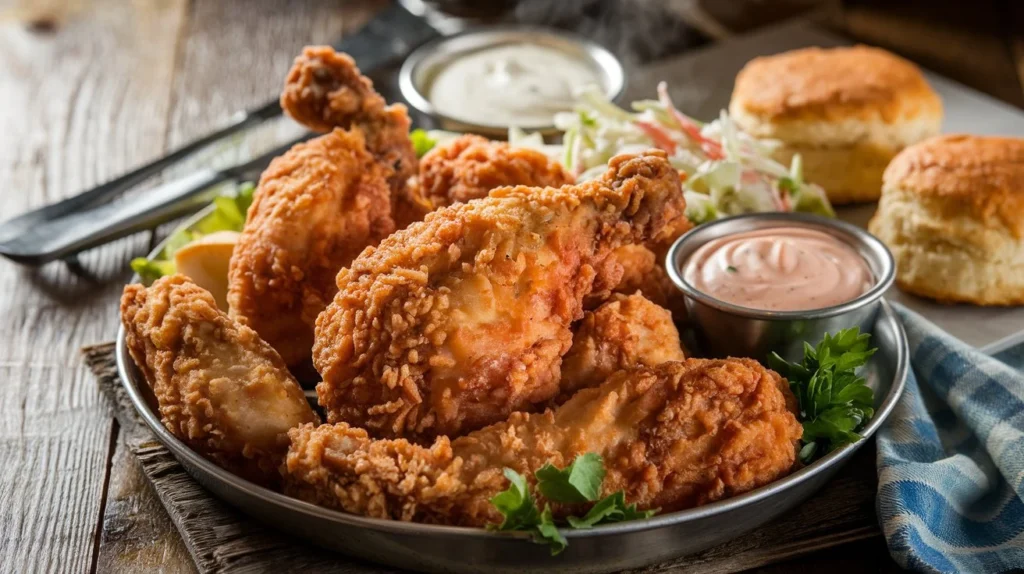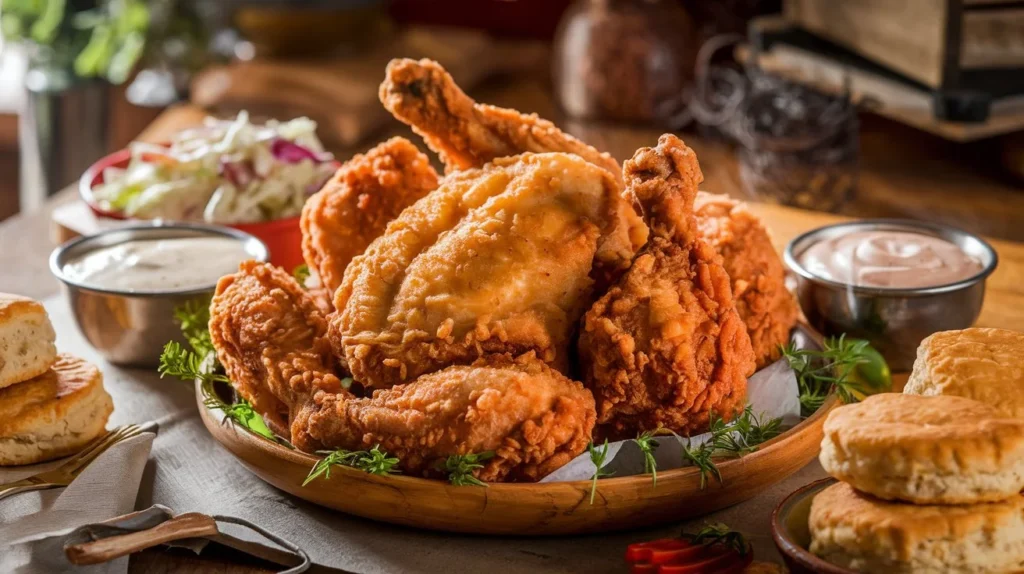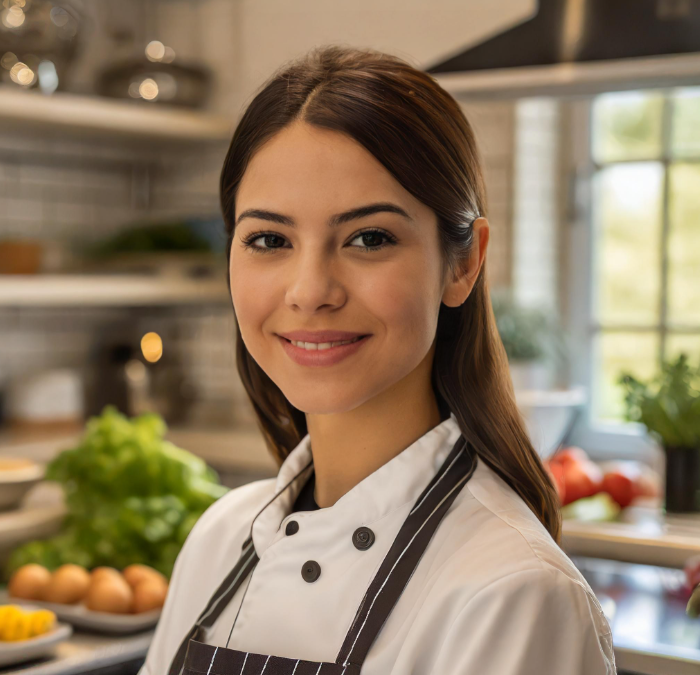Fried Chicken: A Timeless Classic
Who doesn’t love fried chicken? With its crispy golden crust and juicy, flavorful interior, it’s a dish that stands the test of time. But there’s more to fried chicken than meets the eye. From its rich history to the secret techniques for achieving perfection at home, this guide will take you on a journey through everything you need to know about making fried chicken like a pro. So, grab your apron, and let’s dive into the world of this beloved dish!
What Makes Fried Chicken an All-Time Favorite?
Fried chicken isn’t just food; it’s comfort, nostalgia, and celebration wrapped in crispy goodness. Over the years, this iconic dish has earned a special place at family tables, picnics, and holiday feasts. But why has it captured hearts around the globe?
A Perfect Balance of Flavor and Texture
The crispy chicken recipe stands out for its irresistible contrast of crunchy coating and tender meat. Seasonings bring the perfect balance of savory spices, while frying creates a satisfying texture that’s hard to beat.
Versatility That Fits Every Occasion
One of the reasons fried chicken shines is its adaptability. Whether it’s Southern chicken served with mashed potatoes, or spicy Korean fried chicken paired with pickled vegetables, there’s a variation for every taste bud.
Cultural Roots and Global Appeal
The dish has humble beginnings in Southern U.S. cuisine, influenced by African and Scottish cooking traditions. Today, chicken has traveled far and wide, evolving with unique twists like Japanese karaage and oven-baked chicken.
Fried chicken isn’t just food—it’s a celebration of culture, creativity, and sheer deliciousness. Up next, we’ll dive into its fascinating history and how it became a worldwide sensation.
The Origins of Fried Chicken
A Brief History of Fried Chicken
Fried chicken carries a legacy that’s as rich as its flavor. Its origins lie deeply rooted in Southern U.S. cuisine, where it became a cornerstone of comfort food culture. In the South, fried chicken was more than a meal; it was a centerpiece for gatherings, celebrations, and Sunday dinners. Its irresistible combination of crispy skin and juicy, seasoned meat made it a favorite that stood the test of time.
But the story of fried chicken doesn’t start solely in the Southern United States. Its journey begins with the Scottish, who brought the technique of frying chicken in fat to America. Unlike other European methods that often involved boiling or baking, frying produced a crisp, golden crust that quickly gained popularity.
At the same time, African culinary traditions added a profound depth of flavor to the dish. Enslaved Africans in the Southern U.S. introduced bold spices and innovative cooking techniques, enhancing the flavor and texture of fried chicken. These two influences combined to create the iconic Southern fried chicken we know today.
Over the years, fried chicken traveled the globe, adapting to local flavors and customs. Whether marinated in gochujang in Korea, prepared as bite-sized karaage in Japan, or served alongside waffles in the United States, fried chicken evolved into a universal dish. Its global appeal lies in its adaptability, satisfying palates in every corner of the world.
Cultural Influences That Shaped Fried Chicken

The Role of Scottish and African Traditions
The Scottish method of frying chicken in hot fat introduced the crispy element that forms the foundation of modern chicken. This technique combined beautifully with African cooking practices, which brought flavorful spice blends and innovative approaches to preparation. Together, these influences shaped chicken into a dish that is both delicious and deeply rooted in tradition.
Fried Chicken’s Journey Across the Globe
The adaptability of fried chicken allowed it to be embraced by cultures worldwide, creating unique and beloved variations:
- Korean Fried Chicken: This version is double-fried for a crispy crust and coated in sauces like sweet soy garlic or fiery chili paste.
- Japanese Karaage: Bite-sized pieces of chicken are marinated in soy sauce, garlic, and ginger, then fried in potato starch for a light, crunchy texture.
- American Variations: From Nashville hot chicken, known for its spicy kick, to buttermilk-brined Southern classics, the U.S. boasts a diversity of styles that highlight regional flavors.
How Fried Chicken Became a Global Sensation
Fried chicken’s transformation from a regional specialty to an international favorite is a testament to its universal appeal. As people moved across borders, they carried their love for fried chicken with them, introducing it to new places and infusing it with local flavors.
In Asia, it became a popular street food, with vendors frying crispy chicken on bustling corners. In Europe, chefs incorporated unique herbs and spices, creating their own versions of the dish. Today, fried chicken is celebrated in high-end restaurants, fast-food chains, and home kitchens alike.
From humble beginnings to global fame chicken has brought joy and satisfaction to millions. Its history is a delicious blend of tradition, culture, and creativity—a dish that truly belongs to the world.
Preparing Fried Chicken at Home
The Ultimate Guide to Making Fried Chicken at Home
Making fried chicken at home can feel like a culinary adventure. While it might seem intimidating at first, a few essential tools and techniques can elevate your homemade crispy chicken recipe to restaurant-quality perfection.
To begin, having the right equipment is key. A deep fryer isn’t a must, but it’s certainly helpful for maintaining consistent oil temperature. Alternatively, a deep, heavy-bottomed pot works just as well. A kitchen thermometer is essential to keep the oil between 325°F and 375°F, as the perfect temperature ensures even cooking and a crispy coating. Don’t forget a wire rack to drain the fried chicken; this keeps the coating crisp by preventing sogginess.
Next comes choosing the right chicken cuts. Whether you prefer thighs, drumsticks, wings, or breast pieces, bone-in chicken retains moisture better during frying. That said, boneless options can cook faster and are more kid-friendly.
The magic, of course, lies in the seasoning. Essential ingredients include salt, pepper, garlic powder, paprika, and cayenne for a touch of heat. These spices can be adjusted to your taste or expanded with herbs like thyme or oregano. Don’t forget to season both the meat and the coating to ensure every bite is packed with flavor.
How to Brine Chicken for Maximum Flavor
Brining is the secret weapon for juicy, flavorful fried chicken. It involves soaking the chicken in a solution that enhances moisture retention and infuses the meat with flavor.
Why is brining crucial? As the chicken absorbs the brine, it takes in both moisture and seasoning, resulting in meat that remains juicy and tender after frying.
Here’s a step-by-step guide:
- Wet Brining: In a large bowl, dissolve 1/4 cup of salt and 1/4 cup of sugar in 4 cups of water. Add optional flavor boosters like lemon slices, garlic cloves, or bay leaves. Submerge the chicken and refrigerate for 4-8 hours.
- Dry Brining: Rub the chicken generously with salt, pepper, and your choice of spices. Cover and refrigerate for at least 2 hours or overnight.
Both methods work wonders, but wet brining tends to impart deeper flavor, while dry brining allows the skin to dry out for an extra-crispy coating. Choose based on your desired results!
The Secret to the Perfect Batter
When it comes to fried chicken, the batter is everything. A perfect coating should be crispy, flavorful, and slightly golden. But what’s the trick?
Types of Batters: Buttermilk reigns supreme for a reason. Its slight acidity tenderizes the chicken and helps the coating stick better. Start by soaking your chicken in buttermilk for at least an hour—overnight is even better. For an alternative, an egg wash (a mixture of beaten eggs and a splash of milk or water) works well to create a sticky surface for the flour to adhere to.
How to achieve the ideal crispy coating:
- Dredge your brined chicken in seasoned flour. Adding a pinch of cornstarch to the flour creates a lighter, crunchier crust.
- Double-dip for extra crunch! After the first coat, dip the chicken back into the buttermilk or egg wash, then coat it with flour again.
- Shake off any excess flour to avoid clumps.
For added flavor, mix paprika, garlic powder, onion powder, or cayenne into the flour. And don’t skip resting the coated chicken for 10-15 minutes before frying—this helps the coating stick firmly during cooking.
Master these steps, and you’ll soon be making fried chicken that rivals your favorite takeout spot!
Cooking Methods and Tips
How to Cook Fried Chicken Like a Pro
Cooking fried chicken like a pro takes a combination of technique, attention to detail, and a little practice. Two popular methods dominate the kitchen: deep frying and shallow frying. Each comes with its pros and cons.
Deep frying fully submerges the chicken in oil, ensuring even cooking and a consistent crispy crust. It’s quicker and yields excellent results, but it requires more oil and precise temperature control. On the other hand, shallow frying uses less oil and is great for smaller batches. However, it demands frequent turning of the chicken and a bit more vigilance to avoid uneven cooking.
Managing the oil temperature is key regardless of the method. Use a thermometer to maintain a steady heat between 325°F and 375°F. If the oil gets too hot, the coating will burn before the meat is cooked. Too cold, and the chicken will absorb oil, resulting in a greasy texture.
Tips to prevent overcooking or burning:
- Fry similar-sized pieces together to ensure even cooking.
- Allow the chicken to rest for 5-10 minutes after frying; this keeps it juicy inside while the crust remains crisp.
- Always preheat the oil and avoid overcrowding the pan—this drops the temperature and leads to soggy chicken.
Alternative Cooking Methods
Not a fan of deep frying? You’re not alone. There are alternative methods for achieving crispy fried chicken with less guilt.
Air frying is a fantastic option for those seeking a healthier alternative. By using hot, circulating air, air fryers can replicate a crunchy crust without all the oil. Simply coat the chicken in a light batter, spray it with oil, and let the air fryer do the work.
For those avoiding oil altogether, oven-baked fried chicken is a game-changer. Coat the chicken in seasoned flour or breadcrumbs, drizzle with a little oil, and bake it on a wire rack for even cooking. While it lacks the depth of flavor from traditional frying, it’s a lighter, equally satisfying alternative.
Common Mistakes to Avoid When Making Fried Chicken
Even seasoned cooks can encounter mishaps while making chicken. Here are some common mistakes to steer clear of:
- Using cold oil or overcrowding the pan: Cold oil absorbs into the chicken, making it greasy, while overcrowding lowers the temperature, leading to uneven cooking. Heat your oil properly and fry in small batches for the best results.
- Skipping resting periods before and after frying: Resting the coated chicken for 10-15 minutes before frying ensures the batter adheres properly. Similarly, resting after frying allows the juices to redistribute, keeping the meat tender.
- Underseasoning the flour or batter: Bland coating leads to bland chicken. Always season both the chicken and the flour to pack every bite with flavor.
- Turning too often: Frequent flipping disrupts the cooking process and may cause the crust to fall off. Let each side cook fully before turning.
Avoiding these pitfalls will put you on the path to perfectly cooked fried chicken every time.

FAQs Section
Frequently Asked Questions About Fried Chicken
1. What is the best oil for frying chicken?
The best oil for frying chicken is one with a high smoke point, such as canola, peanut, or vegetable oil. These oils maintain stability at high temperatures and don’t overpower the chicken’s flavor.
2. Why is my fried chicken not crispy?
Chicken often turns out soggy when the oil temperature is too low or the chicken isn’t rested after coating. Ensure your oil is hot enough, and let the coated chicken sit for 10-15 minutes before frying.
3. Can you make fried chicken without buttermilk?
Absolutely! If you don’t have buttermilk, substitute it with plain yogurt, milk mixed with lemon juice, or even a simple egg wash. These alternatives still help tenderize the chicken and create a sticky surface for the coating.
4. How long should you fry chicken for?
The frying time depends on the size of the pieces. On average, fry chicken for about 10-12 minutes, ensuring the internal temperature reaches 165°F. Use a meat thermometer to check for doneness.
5. Is air-fried chicken as good as traditional fried chicken?
While air-fried chicken is a healthier alternative, it lacks the rich flavor and texture of traditional frying. However, it’s an excellent option for those looking to cut down on calories and fat.
6. How do you store and reheat leftover fried chicken?
Store leftover fried chicken in an airtight container in the refrigerator for up to 3 days. Reheat in an oven at 375°F for 10-15 minutes to revive the crispy crust. Avoid microwaving, as it can make the coating soggy.
Conclusion
The Unmatched Appeal of Fried Chicken
Fried chicken is more than just a dish; it’s a universal comfort food that brings people together. From its rich history to its endless variations, it has captured the hearts and taste buds of generations. Making chicken at home is a rewarding experience that allows you to experiment with flavors and techniques, creating something truly your own.
So, gather your ingredients, heat your oil, and dive into the world of crispy, flavorful perfection. There’s nothing quite like the satisfaction of biting into a piece of fried chicken you made from scratch. It’s more than food—it’s pure joy on a plate.








